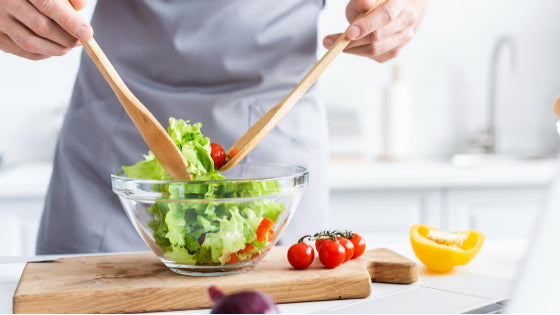It’s easy to overindulge in junk food, whether you’re attending parties, dining out at a buffet restaurant or as you go about your regular day. However, if you’re looking to reach or maintain a healthy weight, portion control is essential.
Ahead, we will tackle several portion-control tricks to help you get started with or boost your smart eating habits. Find out in this post the benefits of portion sizes and how to pick up the habit for a healthier you!
Benefits of Portion Sizes
Portion sizes are as significant as eating nutritious foods. With food portions, you get to eat a wide variety of healthy meals without the guilt of overeating. Take note, however, that portion size is different from serving size. Portions refer to the amount of food that is consumed in one sitting whilst serving is the recommended food intake.
When you’re committed to practising food portion control, you could enjoy some of these benefits:
- It helps in weight management: Slow and mindful eating with smaller portions can curb your cravings and reduce your calorie consumption. Choose to eat balanced meals— which consist of vegetables, whole grains, fruits and proteins such as fish— with the right portion and serving sizes for your healthy weight goals.
- It leads to better digestion: Overindulging could result in indigestion and a feeling of bloating, drowsiness or fatigue. Smaller portions help make digestion more manageable, allowing your body to better absorb the nutrients it needs.
- It helps stabilise your blood sugar level: Having small frequent meals can aid in stabilising your glucose and insulin levels. Frequent eating of large meals could elevate your blood sugar, exposing you to health risks such as diabetes.
How Can You Eat Proper Portion Sizes?
Monitoring the amount of food that goes into your body might feel tedious, but you can follow these tips and tricks to help you start with correct food portion control.
Practice Eating Slowly and Mindfully
By being a slow and mindful eater, you’re giving your stomach ample time (at least 20 minutes) to send signals to your brain that it’s full. You’re reducing your consumption and allowing yourself to appreciate the taste, texture and smell of your food.
Here are quick tips for some mindful and enjoyable eating time:
- Take time to chew your food thoroughly
- Pay attention to your physical hunger cues and stop once full
- Drink a full glass of water 10 minutes before your meal and between bites to slow your eating
- Focus on your eating and avoid distractions during meal time such as browsing your social media and watching television

Try Eating with Smaller Plates
Experts say that you can reduce your food intake if you switch to smaller plates and you’re self-serving your portions. This is an easy way to control your portions and decrease the amount of your average food intake.
You could also use your plate for your portion control. Here’s an available rough balanced meal guide by Healthline but speak first with your nutritionist before trying it out at home, especially if you have special dietary requirements.
- Half a plate for your vegetables or salad
- A quarter of a plate for high-quality protein such as meat, fish, eggs and beans
- A quarter of a plate for your whole grains and starchy vegetables
- Half a tablespoon for your cheese, butter, oils or other high-fat foods
Additionally, serving food on individual plates could be a helpful portion-control practice. It reduces the likelihood of second or third helpings if the extra food is out of sight or kept out of reach.

Don’t Overindulge When Dining Out
Many restaurants are known to offer big servings, making it quite challenging to keep your portions in check when dining out. However, it’s still doable with these simple steps:
- Split the food with your friend
- Request the server that only a half portion of your food be served whilst the other half is to be wrapped up and placed in a “to-go” container
- Listen to your hunger cues. When full, stop eating and spend the rest of the meal enjoying the company of your families and friends.
- If you could, eat in healthy restaurants instead of buffets.
Use Digital Kitchen Scales
Digital food scales can help track your portions at home. These devices are designed to weigh the ingredients accurately and let you know the amount of food you’re consuming, thus preventing you from overeating.
How to use a digital kitchen scale for your portions? You can use this measuring device to weigh your ingredients such as vegetables to ensure you’re not exceeding the recommended amount and that you’re eating the correct portions for each meal.
With the food scale, there is no mistaking that you’re eating 3 ounces of meat per serving, for instance, as suggested and not more. Some digital food scales such as our Smart Nutrition Scale are Bluetooth-enabled to help you keep track of your portions and what you’re eating.
Takeaway
Portion size is important in taking control of your health through proper dieting. With commitment, discipline and the right frame of mind, portion control will make a big difference in your fitness and health journey. Learn how to ramp up your smart nutrition habits and healthy lifestyle here.
Renpho Health Tips
-

How to Pair the RENPHO Smart Body Fat Scale to the RENPHO Health App
JUNE 24, 2021
Read more >
-

How Does The Renpho Smart Scale Work? How Are They Different From Each Other?
AUGUST 3, 2020
Read more >
-

What Is FTP and How Can It Improve Your Workout
JULY 9, 2021
Read more >
-

What Type of Indoor Exercise Bike is Best for You?
JUNE 24, 2021
Read more >
-

Renpho Seasonal Staff Picks 2021
DECEMBER 5, 2021
Read more >

